 |
Sikorsky MH-53M Pave Low IV |
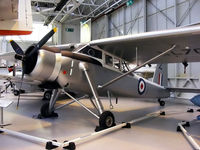 |
The last Pioneers were withdrawn in 1969, after being used by 'C' Flight of No.20 Squadron in Singapore to guide their Hunters onto ground targets. This aircraft is the only surviving example of the type. |
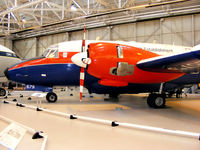 |
The prototype Varsity T MkI made its maiden flight on 17 July 1949. The RAF took its first deliveries in October 1951 which went to No.201 Squadron, Advanced Flying School at Swinderby, Lincolnshire. |
 |
preserved in 'Red Arrows' colours at the RAF Museum, Cosford |
 |
de Havilland Mosquito at the RAF Museum, Cosford |
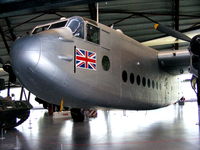 |
Manufactured by Avro and incorporating the wings, tail, undercarriage and engines of the Lancaster bomber, the York was to prove a useful military and civilian transport aircraft in war and peace. |
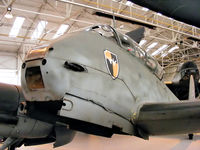 |
The origins of the Me410 Hornisse (Hornet) can be traced to the catastrophic failure of an earlier design the Me210. A marked improvement on its predecessor, the Me410 entered front line service in March 1943 and 1100 were built. |
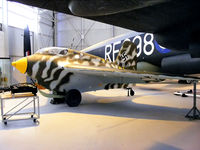 |
Messerschmitt Me 163B-1a Komet |
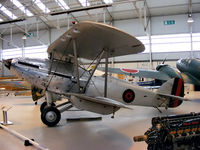 |
The Hind was a development of the Hart and was supplied to the Royal Air Force as an interim type to permit the formation of new bomber squadrons during the early expansion schemes prior to the outbreak of the Second World War. |
 |
The Hind was a development of the Hart and was supplied to the Royal Air Force as an interim type to permit the formation of new bomber squadrons during the early expansion schemes prior to the outbreak of the Second World War. |
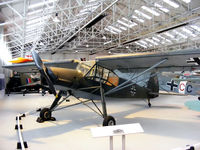 |
Originally designed in 1935 to perform the roles of casualty evacuation, army co-operation and liaison, the Storch (Stork) was noted for its remarkable STOL (Short Take-Off and Landing) performance. |
 |
The first prototype flew on 24 March 1935 and subsequently 174 of the type were ordered. The Anson became the first aircraft in RAF service to have a retractable undercarriage. Despite being obsolescent, it remained in Coastal Command service until 1942. |
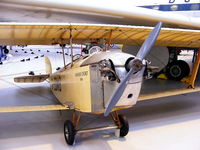 |
The Cygnet was the first aircraft to be designed by Sydney Camm after he joined what was then the Hawker Engineering Company. Two were built as the company's entries in the Air Ministry Light Aeroplane Competition of 1924, in which they performed well. |
 |
Percival P.56 Provost T1 preserved at the RAF Museum, Cosford |
 |
Entering service in 1953, the Pembroke took over from the venerable Anson in the light transport and communications role. It was developed from the Prince civil transport having a longer wing to carry an increased all-up weight. |
 |
Mitsubishi Ki-46 'Dinah' |
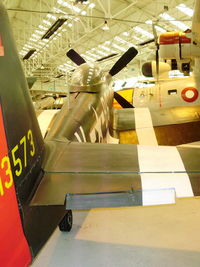 |
North American P-51D Mustang |
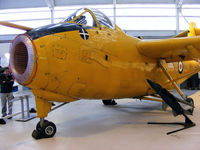 |
This unusual looking research aircraft was capable of flight at speeds as low as 51.5kph (32mph) by virtue of its 'jet flaps' which used thrust ducted from the main engine to increase lift. |
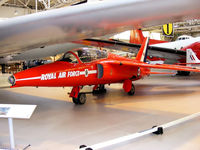 |
preserved in 'Red Arrows'colours at the RAF Museum, Cosford |
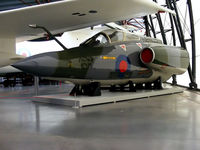 |
Blackburn Buccaneer S1 Nose section, preserved at the RAF Museum, Cosford |
 |
Fieseler Fi.156 C-7 Storch, preserved at the RAF Museum, Cosford |
 |
Nicknamed 'Flaming Pencil', only two Bristol 188s ever flew, a third being used for ground tests. |
 |
Air brakes on the Bristol 188 |
 |
Focke Achgelis FA330. This aircraft was actually an unpowered autogyro kite, intended for use as an observation platform for German U-Boats |
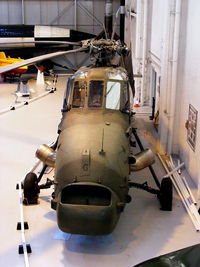 |
First flown in January 1962, the RAF variant, the HC Mk 2, was a high-performance development of the Mk 1, with two coupled Bristol Siddeley Gnome turboshaft engines. It was intended for transport, ambulance and general purpose duties |
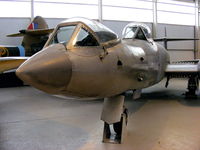 |
A much modified Meteor F8 fighter, the 'prone position' Meteor, was used to evaluate the advantages of coping with the effects of gravity while flying lying down. |
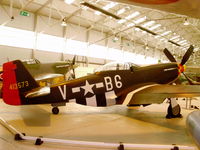 |
North American P-51D Mustang |
 |
Preserved at the RAF Museum, Cosford |
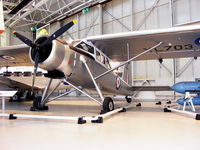 |
In the 1950s the Pioneer amazed the crowds at Farnborough air shows by taking-off across the runway instead of along it. The Pioneer's outstanding short take-off and landing performance made it ideal for operations in the jungles of Malaysia and Borneo |
 |
Hawker Hurricane IICB, Preserved at the RAF Museum, Cosford |
 |
Bristol Siddeley Olympus BOl.22R (Mk. 320) turbojet |
 |
North American P-51D Mustang |
 |
The Hurricane first flew in November 1936. It was the main aircraft of RAF Fighter Command squadrons during the Battle of Britain where it equipped thirty-two squadrons between July and October 1940. |
 |
Messerschmitt Me 163B-1a Komet |
 |
Preserved at the RAF Museum, Cosford |
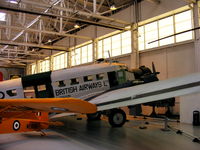 |
The Ju52/3m, flew in April 1932. Orders for this robust aircraft, which could carry seventeen passengers or eighteen troops, soon started coming in and included an order for three from the pre-war British Airways, whose colours this example is displayed |
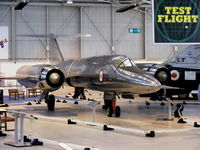 |
Although a maximum speed of Mach 1.88 was reached this fell short of the required Mach 2 performance. This, combined with fuel leaks, an endurance of only 25 minutes and the cancellation of the Avro 730, led to the cancellation of the Bristol 188 project |
 |
Royal Danish Air Force |
 |
Koninklijke Marine (Royal Netherlands Navy) |
 |
built in April 1939, this is the oldest surviving example of a Spitfire mkI |
 |
the "prone position" cockpit |
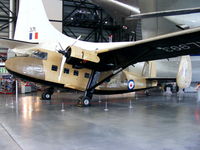 |
Known as the 'Twin Pin', the Twin Pioneer was a follow-up to the same company's single-engined short take-off and landing (STOL) transport, the Pioneer, and like the latter required an area only 30m (99ft) by 275m (902ft) in which to operate. |
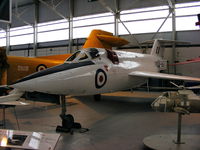 |
One of several projects designed to meet an Operational Requirement for a rocket interceptor, work on the SR53 started in 1952. However, due to development delays the first prototype did not fly until 16 May 1957. |
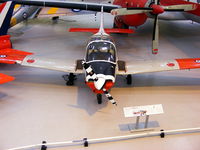 |
Preserved at the RAF Museum, Cosford |
 |
G-AOVF was built for BOAC and first flew on 18 December 1957. The highlight of its career was its use by HRH Princess Margaret on a tour of the West Indies in 1958. G-AOVF flew into Cosford from Southend on 31 May 1984. |
 |
Five Pucara's survived the Falkland war in reasonable condition and were shipped back to the UK. This aircraft was chosen for performance evaluation by the AAEE at Boscombe Down and was returned to flying condition during 1983 |
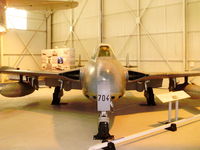 |
Swiss Air Force de Havilland Venom FB4 |
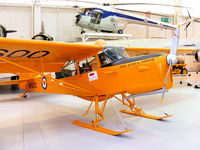 |
In 1955 Auster Aircraft Limited modified two T7s (WE563 and WE600) for the 1956 Commonwealth Trans-Antarctic Expedition led by Dr Vivian Fuchs, changes included extra radio equipment, larger tail surfaces, the ability to be fitted with floats or skis. |
 |
The Valiant was the first of Bomber Command's V class aircraft and established Britain's air-borne nuclear deterrent force before pioneering operational in-flight refuelling in the Royal Air Force. |
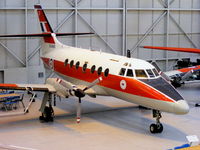 |
originally designed by Handley Page Limited as an executive light transport/feederliner the HP137 Jetstream first flew at Radlett in August 1967 but after the company went into liquidation in August 1969 production transferred to Scottish Aviation Ltd |
 |
The Museum's aircraft was used during the war as a hack for the US 8th Air Force. After purchase from private owners in 1973, it spent many years in deep storage, before restoration for the Museum by the Medway Aircraft Preservation Society in 1999. |
 |
de Havilland Mosquito at the RAF Museum, Cosford |
 |
Yokosuka MXY7 Ohka, was a rocket powered piloted aircraft to be carried and launched from a 'Mother' aircraft, glide as far as possible before making a final rocket powered approach to impact on its target. |
 |
Focke Achgelis FA330. This aircraft was actually an unpowered autogyro kite, intended for use as an observation platform for German U-Boats |
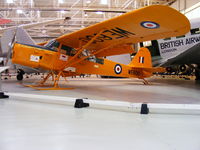 |
In 1955 Auster Aircraft Limited modified two T7s (WE563 and WE600) for the 1956 Commonwealth Trans-Antarctic Expedition led by Dr Vivian Fuchs, changes included extra radio equipment, larger tail surfaces, the ability to be fitted with floats or skis. |
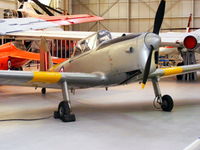 |
One of the RAF's longest serving aircraft types, the Canadian designed Chipmunk entered RAF service in 1950. Chipmunks replaced the Tiger Moth as an initial pilot trainer, offering modern features such as flaps, brakes, radio and an enclosed cockpit |
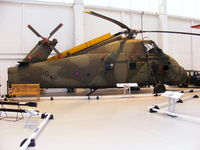 |
First flown in January 1962, the RAF variant, the HC Mk 2, was a high-performance development of the Mk 1, with two coupled Bristol Siddeley Gnome turboshaft engines. It was intended for transport, ambulance and general purpose duties |
 |
de Havilland Mosquito which was used in the film '633 Squadron' at the RAF Museum, Cosford |
 |
The first flight of P1 WG760 was on 4 August 1954, just 10 years after the RAF's first jet aircraft, the Meteor, entered squadron service. It was experimental and was the basis for the RAF's front line fighter, the EE Lightning |
 |
A single seat fighter, 415 Hunter F Mk 6s were produced, some 380 of them for the RAF, this variant introducing improved flying controls making it an ideal aerobatic aircraft, serving with the RAF Black Arrows and Blue Diamonds aerobatic display teams |